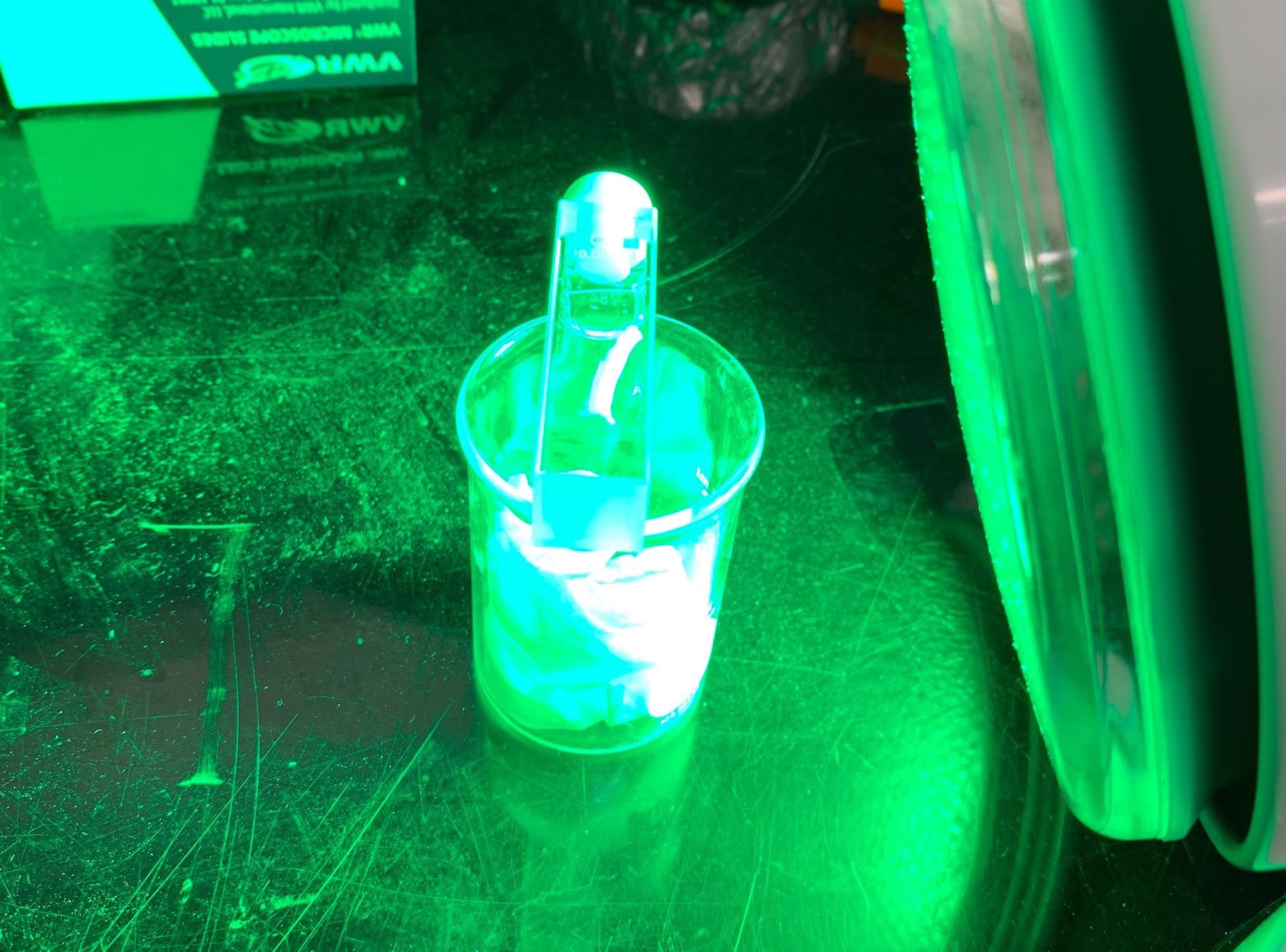The University of British Columbia (UBC) scientists have created an economical, non-toxic coating for nearly any fabric which reduces the infectivity of the virus that results in COVID-19 by approximately 90%.
In the future, people may be able to spray it on fabric themselves.
 Material coated in polymer in small-scale tests with a green lamp. Image Credit: Taylor Wright.
Material coated in polymer in small-scale tests with a green lamp. Image Credit: Taylor Wright.
When you’re walking into a hospital, you want to know that pillow you’re putting your head onto is clean. This coating could take a little bit of the worry off frontline workers to have Personal Protection Equipment with antimicrobial properties.
Taylor Wright, Study Lead Author and Doctoral Student, Department of Chemistry, University of British Columbia
Scientists immersed fabric in a solution of a bacteria-killing polymer which comprises a molecule that releases sterilizing forms of oxygen when irradiated with light. They then employed an ultraviolet (UV) light to change this solution to a solid, adhering the coating to the fabric.
This coating has both passive and active antimicrobial properties, killing microbes immediately upon contact, which is then amped up when sunlight hits the cloth.
Dr. Michael Wolf (he/him), Senior Study Author and Professor of Chemistry, University of British Columbia
The two components can be safely used by humans, and the whole process is done in roughly 1 hour at ambient temperature, says Wright. It also renders the fabric hydrophobic, meaning microbes are less likely to adhere to the cloth and does not appear to impact the fabric’s strength.
Furthermore, the coating can be applied on nearly any fabric, including cotton, denim, polyester and silk, with applications in masks, hospital fabrics and activewear. While other such technologies may require high energy use, chemical waste or costly equipment, the UBC technique is comparatively easy and inexpensive, says Wright.
“All we need is a beaker and a light bulb. I’m fairly certain I could do the whole process on a stove.”
To verify the bug-killing properties of the coating, the scientists bathed treated fabric in bacterial soups of Escherichia coli (E. coli) and methicillin-resistant Staphylococcus aureus (MRSA), both key sources of hospital-acquired contagions.
They discovered there were 85% of viable E. coli bacteria still present after 30 minutes, which fell to 3% when the treated cloth was irradiated with green light for the same time span. Likewise, 95% of viable MRSA bacteria endured, reducing to 35% under green light. No bacteria were found after 4 hours.
Given that fluorescent lights or sunlight have a lesser percentage of green, the researchers anticipate similar but less strong results for fabric irradiated with those light sources, says Wright.
Particularly in the Pacific Northwest, it’s not always a sunny day. So, at all times you’re going to have that layer of passive protection and when you need that extra layer of protection, you can step into a lit room, or place the fabric in a room with a green light bulb—which can be found for about $35 online.
Taylor Wright, Study Lead Author and Doctoral Student, Department of Chemistry, University of British Columbia
The scientists also analyzed whether the coating decreased the infectivity of SARS-CoV-2, the virus causing COVID-19, by dipping treated fabric in a solution of the virus particles and then incorporating that solution to living cells to observe if they could contaminate them.
They learned the passive properties were not successful against the virus, but when the treated fabric was irradiated with green light for 2 hours, there was approximately a 90% reduction in the infectivity of SARS-CoV-2.
“In other words, only one-tenth of the amount of virus signal was detected on cells infected with the UV-fabric and light treated virus”, says co-author Dr. François Jean (he/him), professor of virology at UBC.
The effectiveness of the new fabric against SARS-CoV-2 was shown by Dr. Jean’s team at UBC FINDER, the advanced level three biocontainment facility set up by Dr. Jean in 2010.
The researchers learned they required an 18 cm2 piece of fabric to destroy microbes with material containing 7% weight of the active ingredient, but raising this to 23% weight boosted the efficiency of the fabric at four times less material, explains Wright.
The scientists also discovered that placing the fabric under green light for over 24 hours failed to yield the sterilizing forms of oxygen, pinpointing an area for additional study. This is a similar effect to the color fading on fabric that has been exposed to sunlight for a very long time.
Biomanufacturing face masks based on this new UBC technology would represent an important addition to our arsenal in the fight against COVID-19, in particular for highly transmissible SARS-CoV-2 variants of concern such as Omicron, says Dr. Jean.
Dr. François Jean (he/him), Study Co-Author and Professor of Virology, University of British Columbia
The coating can also be used in activewear, with an “anti-stink” coating spread across areas where people sweat, destroying the bacteria that create odor. Hospital fabric and activewear companies are already keen to apply the technology, and the university has filed for a patent in the United States, expresses Dr. Wolf.
Journal Reference:
Wright, T., et al. (2022) Photodynamic and Contact Killing Polymeric Fabric Coating for Bacteria and SARS-CoV-2. Applied Materials & Interfaces. doi.org/10.1021/acsami.1c14178.